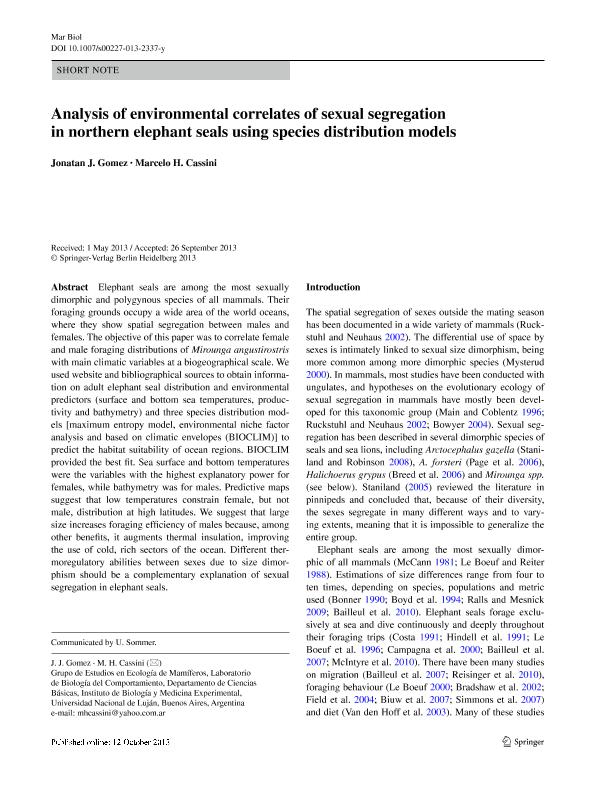Mostrar el registro sencillo del ítem
dc.contributor.author
Gomez, Jonatan José
dc.contributor.author
Cassini, Marcelo Hernan

dc.date.available
2016-05-23T13:27:53Z
dc.date.issued
2014-02-28
dc.identifier.citation
Gomez, Jonatan José; Cassini, Marcelo Hernan; Analysis of environmental correlates of sexual segregation in northern elephant seals using species distribution models; Springer Heidelberg; Marine Biology; 161; 2; 28-2-2014; 481-487
dc.identifier.issn
0025-3162
dc.identifier.uri
http://hdl.handle.net/11336/5775
dc.description.abstract
Elephant seals are among the most sexually dimorphic and polygynous species of all mammals. Their foraging grounds occupy a wide area of the world oceans, where they show spatial segregation between males and females. The objective of this paper was to correlate female and male foraging distributions of Mirounga angustirostris with main climatic variables at a biogeographical scale. We used website and bibliographical sources to obtain information on adult elephant seal distribution and environmental predictors (surface and bottom sea temperatures, productivity and bathymetry) and three species distribution models [maximum entropy model, environmental niche factor analysis and based on climatic envelopes (BIOCLIM)] to predict the habitat suitability of ocean regions. BIOCLIM provided the best fit. Sea surface and bottom temperatures were the variables with the highest explanatory power for females, while bathymetry was for males. Predictive maps suggest that low temperatures constrain female, but not male, distribution at high latitudes. We suggest that large size increases foraging efficiency of males because, among other benefits, it augments thermal insulation, improving the use of cold, rich sectors of the ocean. Different thermoregulatory abilities between sexes due to size dimorphism should be a complementary explanation of sexual segregation in elephant seals.
dc.format
application/pdf
dc.language.iso
eng
dc.publisher
Springer Heidelberg

dc.rights
info:eu-repo/semantics/openAccess
dc.rights.uri
https://creativecommons.org/licenses/by-nc-sa/2.5/ar/
dc.subject
Sexual Segregation
dc.subject
Ellephant Seals
dc.subject
Species Distribution Models
dc.subject
Regulacion de La Temperatura Corporal
dc.subject.classification
Ecología

dc.subject.classification
Ciencias Biológicas

dc.subject.classification
CIENCIAS NATURALES Y EXACTAS

dc.title
Analysis of environmental correlates of sexual segregation in northern elephant seals using species distribution models
dc.type
info:eu-repo/semantics/article
dc.type
info:ar-repo/semantics/artículo
dc.type
info:eu-repo/semantics/publishedVersion
dc.date.updated
2016-05-10T13:47:34Z
dc.identifier.eissn
1432-1793
dc.journal.volume
161
dc.journal.number
2
dc.journal.pagination
481-487
dc.journal.pais
Alemania

dc.journal.ciudad
Berlin
dc.description.fil
Fil: Gomez, Jonatan José. Consejo Nacional de Investigaciones Científicas y Técnicas. Instituto de Biología y Medicina Experimental (i); Argentina. Universidad Nacional de Lujan; Argentina
dc.description.fil
Fil: Cassini, Marcelo Hernan. Consejo Nacional de Investigaciones Científicas y Técnicas. Instituto de Biología y Medicina Experimental (i); Argentina. Universidad Nacional de Lujan; Argentina
dc.journal.title
Marine Biology

dc.relation.alternativeid
info:eu-repo/semantics/altIdentifier/doi/10.1007/s00227-013-2337-y
dc.relation.alternativeid
info:eu-repo/semantics/altIdentifier/url/http://link.springer.com/article/10.1007/s00227-013-2337-y
dc.relation.alternativeid
info:eu-repo/semantics/altIdentifier/doi/10.1007/s00227-013-2337-y
dc.relation.alternativeid
info:eu-repo/semantics/altIdentifier/doi/http://dx.doi.org/10.1007/s00227-013-2337-y
Archivos asociados
